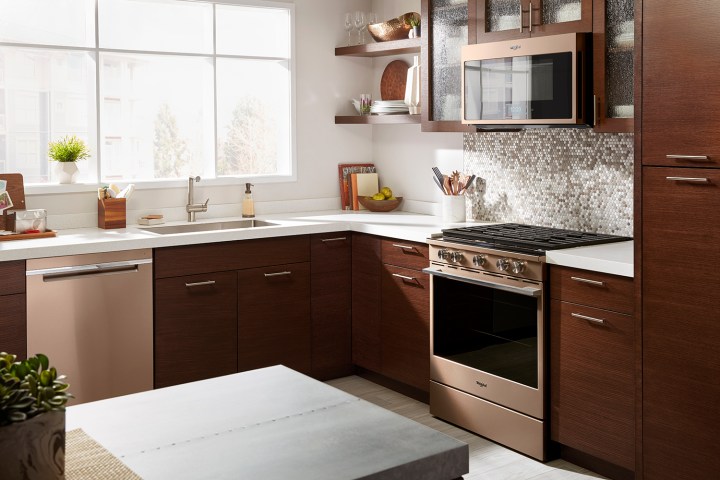
When it comes to buying home appliances—regardless of the amount of research we door reviews we read—we still hope we purchased one that’s reliable. Rightfully so, home appliances tend to go the distance, often lasting over ten years before replacing them. The question is, how many times will you need to call a repairman to fix them? That’s what Puls, a home services company that provides appliance installation and repair, discovered. The company’s first annual National Appliance Report ranks the top appliance brands based on reliability, ease of use, and overall value.
The report is full of tons of useful information that we’ll cover shortly, but here are the brand standouts by appliance category:
Appliance Brand Reliability Winners and Recommendations:
Refrigerators: Whirlpool, KitchenAid, Samsung
Dishwashers: Bosch, Whirlpool, KitchenAid
Stove + Ranges: GE, Whirlpool, KitchenAid
Dryers: Whirlpool, LG, Samsung
Washing Machines: Whirlpool, LG, Samsung
The brands evaluated in the report are Bosch, Frigidaire, Kenmore, KitchenAid, LG, Maytag, Samsung, Sears, and Whirlpool. Puls’ service technicians rated the brands based on reliability. Essentially, these manufacturers appliances don’t breakdown a lot, the cost of repairing them isn’t astronomical, and they have a solid overall value.
Which Brands Should You Avoid?
The report doesn’t list the worst brand for each home appliance. However, there are brands that Puls’ appliance repair technicians don’t recommend as often. Here are the brands that didn’t top the list:
Refrigerators: Bosch and Frigidaire
Dishwashers: Frigidaire and Maytag
Stove + Ranges: Maytag and LG
Dryers: Frigidaire and Bosch
Washing Machines: Frigidaire and Bosch
Better Check Your Fridge in July
Perhaps the most interesting finding is that your refrigerator is most likely to breakdown in July. The biggest issue is that the fridge isn’t cooling properly. Other issues technicians hear about in July include a broken ice maker or that the appliance is leaking. July tends to get pretty hot, and your fridge has to work a lot harder than say an average day in October.

“Your refrigerator needs to keep its internal temperature steady, forcing it to work harder on those hot days. That puts stress on the compressor, which is the mechanism in the refrigerator that actually cools everything,” explains James Granado, Appliance Repair Manager at Puls. “If the compressor breaks or stops working, your refrigerator will not cool properly. People also use the ice maker on their refrigerator more often during summer, for cold drinks or to fill coolers.”
Puls didn’t find a similar correlation to between time of year and when an appliance typically breaks for the other products mentioned in the report. Granado cautions, “One thing people don’t really think about is that there are more thunderstorms during summer and these storms can cause electrical surges that will fry the control board on any kind of appliance. If that happens, it will usually require scheduling a repair technician to come out and fix it.”
Which Appliance Will Cost the Most to Repair?
There are a lot of variables that go into repairing an appliance. Type of repair needed, parts, brand, and model are all considerations. The report evaluates general repairs for different appliances. Overall, the company found that a freezer is the most expensive item to repair, costing on average $348. A microwave is on the other end of the spectrum and costs an average of $195 to repair. For that money, you can buy a new model (unless it’s installed in the kitchen).
The report doesn’t mention whether products breakdown during or after the warranty period. There are a variety of warranties you can purchase throughout the lifetime of an appliance. However, in Granado’s ten years of repairing appliances, he says parts tend to break two to three years after the appliance was purchased.
According to the report, repair costs also vary by city. If you think New York tops that list, you’d be wrong. You may be surprised to learn that it is more expensive to repair appliances in both Philadelphia ($260) and Washington D.C. ($245). Dallas is the most affordable with an average repair cost of $207. This information will also vary based on where you live, as well as which appliance you need to repair.
“While we showed averages in the report, the cost of the repair varies greatly depending on the brand and model,” adds Granado. “If you purchase a refrigerator for $3,000, replacing the compressor could cost around $600. Whereas, for a more affordable refrigerator, the repair would be less expensive.”
Read the full National Appliance Repair report on the Puls site.
Editors' Recommendations
- Narwal’s Freo X Ultra honors reliable, maintenance-free cleaning for 7 weeks
- Samsung goes all-in with AI, reveals several new smart home appliances at CES 2024
- Dyson is gearing up to launch the most powerful robot vacuum in the world
- Samsung reveals futuristic new smart home appliances for CES 2023
- Google Home’s web preview is live — and it’s missing most features


